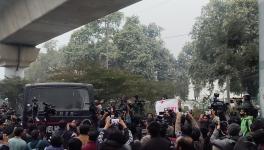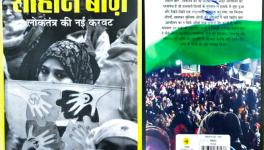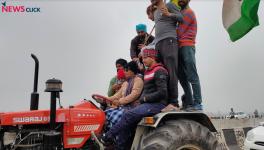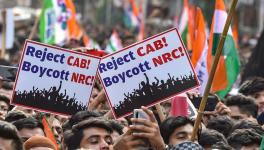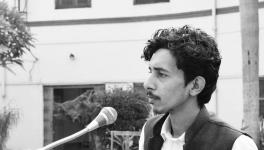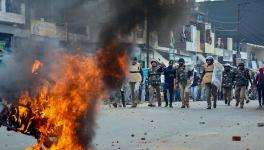The Lone-Wolf Protesters of Revolutionary Street, Jamia Nagar
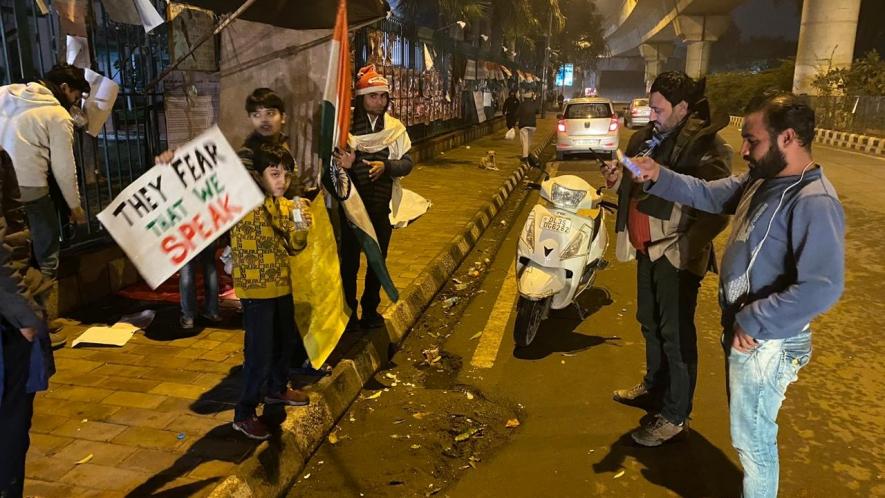
Abdul Matloob still remembers the time and date: 3.30 am, 27 December. He was returning from Holy Family Hospital, where he had taken his brother in an emergency, when the headlights of his car shone on a nondescript man—barely a couple of inches above five feet and slightly built—standing at Gate No 7 of Jamia Millia Islamia. The man held out a placard in the direction from where an occasional car or motorcycle would swish past.
“It is true then,” Matloob thought.
He had read in WhatsApp forwards about a lone-wolf protester who plants himself around 10 am at Gate No 7 and stays there until 5 or 6 am. Through his nearly 20 hours of vigil, the WhatsApp forwards claimed, he holds a placard denouncing Prime Minister Narendra Modi’s triad of the Citizenship Amendment Act, the National Population Register, and the National Register of Indian Citizens.
The protester’s name: Mohd Sadiq Khan.
Matloob, who runs a bakery his family has owned for six generations, sighted Khan on three late-night runs on separate dates, marvelling at his tenacity in braving the bitingly cold nights and yet grasping the futility of his mode of protest. It is impossible for Khan to elicit a response from the Modi government that has been indifferent, even disdainful, of the countrywide protests against the interlinked process of CAA-NPR-NRC, Matloob thought.
Khan is an extreme expression of the tumult on Revolution Street, which is what the road running past Gate No 7 should be named. Every day, between 11 am and 12 pm, the protesters barricade one side of a dual carriageway. On the pavement sits a cage of steel and wood, mimicking the detention centres which are supposed to be constructed countrywide for housing illegal immigrants; photos from the anti-colonial movement flutter in the breeze. Around 5.30 pm, the road is swept clean before it is opened to traffic. They slowly disperse over the next few hours.
But not Khan, who continues to hold his placard even as Jamia Nagar goes to bed. He returns home only when the clock chimes 6 am, at times an hour earlier.
Giving Khan company through the day and for a part of the night is Razi Anwar, who stands around 200-300 meters away, near the mausoleum of Zakir Hussain, India’s third President. From around his neck hangs a placard with the photo of Dr BR Ambedkar and lines demanding the withdrawal of CAA-NPR-NRC.
Protests often thread together people who are more dissimilar than alike, as Khan and Anwar are in their class background.
Khan is 20 years old, passed Class X even as he worked; his job before he hit Revolution Street was of an assistant night guard that earned him Rs 10,000 a month. Khan’s father is a marginal farmer in Samda village, Sitapur district of Uttar Pradesh, who also doubles up as an agriculture labour.
By contrast, Razi Anwar’s family owns 20 bighas of land in Araria, Bihar. He did his BA and MA in Arabic from Jawaharlal Nehru University and is currently working on his PhD thesis, for which he gets a government stipend of Rs 35,500 a month. His topic of research: Iraqi society after the invasion of the United States, in the light of writings of Ahmed Saadawi. A novelist, poet and documentary film-maker, Saadawi’s Frankenstein in Baghdad won, in 2014, the International Prize for Arabic Fiction.
Anwar, too, is a lone-wolf protester. He comes here in the morning, but stays, as he said, until 11 pm, at times 1 or 2 am. “I also go to protests elsewhere in Delhi, in the gear I am in,” Anwar said to me, his torso swathed in the tricolour, its saffron strip wrapped around his head.
Khan and Anwar are the oddballs of Revolution Street, Jamia Nagar, who constitute the unique psychological markers of a collectivity buffeted by a series of precipitous actions of the Indian state.
Matloob befriended Khan during one of the daytime protests. “I tried to persuade Khan that even though he was exposing himself to such inclement weather, the government is not going to care,” Matloob says. He ensures dinner is served to Khan daily, even though it requires a lot of cajoling to have him accept it.
Khan thinks his wilful courting of hardship is a small price to pay for the nation. “This is not about Hindu-Muslim; this is about saving the Constitution and fighting for the poor,” Khan said to me. His remark would seem to suggest he has been tutored or he has picked these phrases from the posters and graffiti on the walls of Jamia Nagar. To what extent would a Class X-pass know about the constitutional intricacies?
My scepticism stands challenged as Khan says that the CAA-NRC tipped over his “pitcher of patience”. He says, “The government first hit us with demonetisation. Then it scrapped Art 370, then came the judgement on the Babri masjid, and now the NRC. Do you think poor people, Hindus and Muslims alike, can produce documents to establish their identity?”
His “pitcher of patience” was ultimately shattered with the brutal police crackdown on the Jamia protests of 15 December. “Because of poverty I could not study. My protest is for the students who can afford an education and build a future for themselves and India.”
Noble sentiments of protesters rarely move any government. He will soon tire out, I suggest, pointing to the futility of his vigil. “Aap samjhe nahin [you don’t get it],” Khan said. “My protest is to convey a message to all that they must leave the warmth of their blankets and security of their lives to protest against the CAA-NRC.”
Regardless of whether or not they will heed him, Khan has become a celebrity on Revolutionary Street. People stop to take selfies with him, or to pass a bottle of water or an apple. A night after I met him, Matloob gave me a video call at midnight—parents had brought their children to introduce them to the man who stands through the night, even as they sleep, with a placard admonishing the government.
Anwar’s lone-wolf protest was sparked by his experiences during the 15 December crackdown. He had rushed to hide on the first floor of Zakir Hussain Library. The police soon barged in.
“We were ordered to raise our arms and troop out,” Anwar recalled. “I did not and I was hit on the thigh with a baton.” They were made to march to Sukhdev Vihar Metro Station, where they were ordered to disperse. Anwar later returned to the campus to see blood splattered around.
“Something snapped in me,” he said, his spirit broken, his psyche scarred. What was he to do?
Anwar sent emails to the Chief Justice of India, the National Human Rights Commission and the National Commission for Women, detailing the brutal disruption of a peaceful march. A formal acknowledgement was received from the NHRC, but not from the CJI, who, before he was sworn-in, had pointed to some having “too much freedom of speech.”
On the night of mayhem at Jamia, Anwar was reminded of the Kosi river spilling over its banks in 2017 and flooding Araria, his home district. Anwar said an estimated 70 lakh were rendered homeless. With the water gushing in, how many would have thought of picking up their birth certificates or identity documents? Anwar asked himself.
“Iraq was ruined by a foreign power,” Anwar says, drawing on his research work. “But India is being ruined by its own government.” It is to save India’s underprivileged he has chosen to become a lone-wolf protester. Later, in a telephonic chat, Anwar outlined another reason: “The government imposes section 144 at the sites of protests. But what will it do in case lone-wolf protesters start roaming the city?”
It is smart of Anwar to conceive such an idea against the government that brooks no dissent. Protesters are known to show creativity under duress. “Khan and Anwar are expressions of the junoon [passion] gripping the community over the CAA-NPR-NRC,” said Ovais Sultan Khan, a social activist.
It is, perhaps, also an expression of the social dynamics—that when any government becomes irrational, the resistance to it also turns off-beat. Khan and Anwar are voluntarily punishing themselves to test the limits of their endurance, to demonstrate that their will is as insurmountable as Modi’s.
The author is a freelance journalist. The views are personal.
Get the latest reports & analysis with people's perspective on Protests, movements & deep analytical videos, discussions of the current affairs in your Telegram app. Subscribe to NewsClick's Telegram channel & get Real-Time updates on stories, as they get published on our website.









